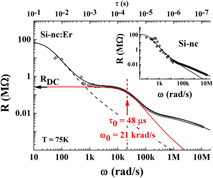Published online by Cambridge University Press: 02 October 2014

To fabricate practical light-emitting devices, identification and minimization of nonradiative processes are necessary. In this study, an electrical measurement technique for time-resolved analyses of nonradiative processes was proposed. From the comparison between a commercial light-emitting diode (LED) and rare-earth-doped semiconductors, the technique, called electrical frequency-response analysis (FRA), revealed differences in the charge behaviors in the pn junction of bulk semiconductors and impurities. Although the charge response time constant on the order of a nanosecond realized effective recombination of the electron–hole pairs in a LED, the time constant larger than a microsecond still limited the emission intensity of the rare-earth-doped semiconductors such as Er-doped Si nanocrystals and GaAs with Er and O codopants. The energy-loss processes of the Er-doped semiconductors were investigated, and countermeasures to enhance the emission intensity were proposed.
This paper has been selected as an Invited Feature Paper.